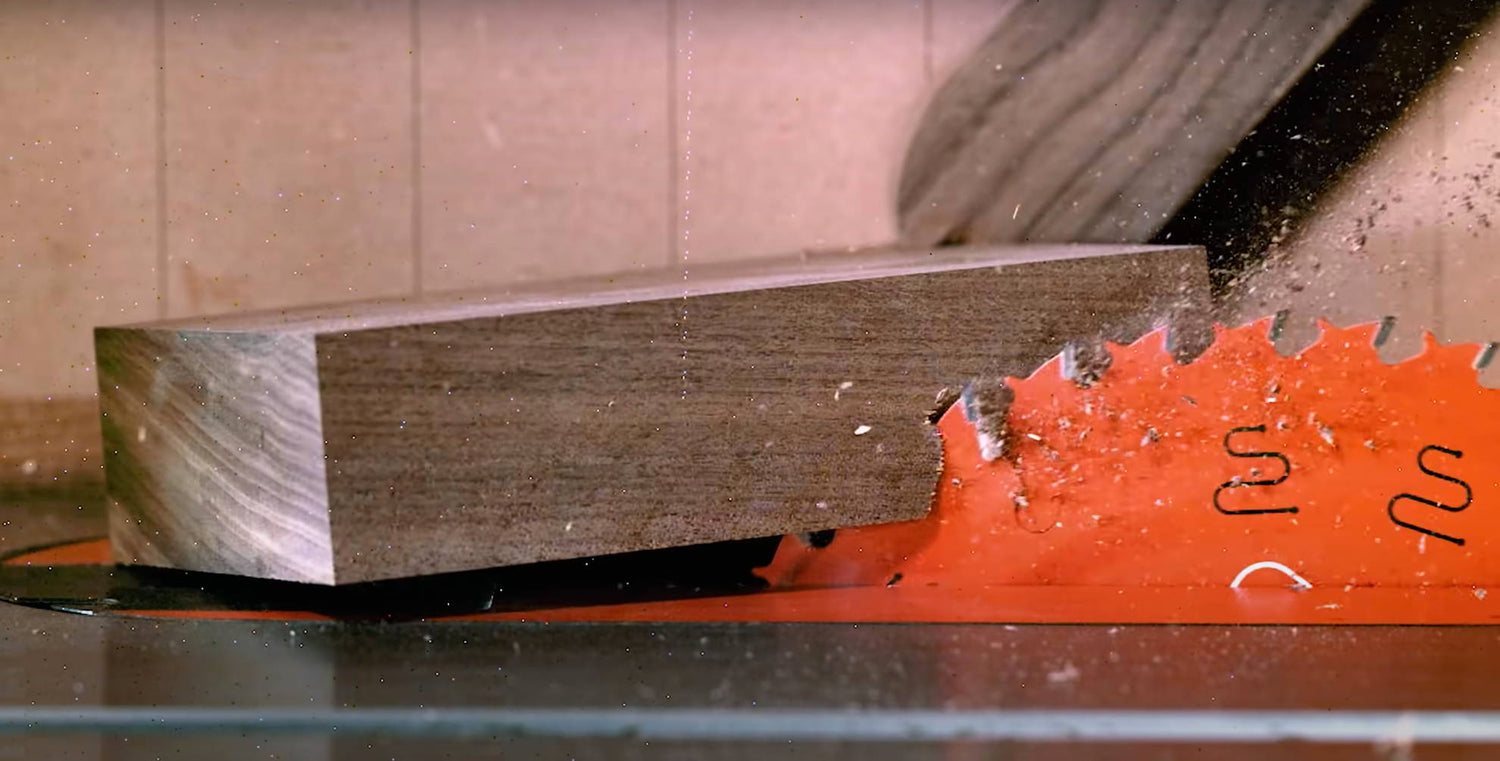What is table saw kickback? Table saw kickback is when a piece of wood is suddenly thrown back toward the operator during a cut. It’s dangerous, but can be prevented. This guide covers table saw kickback safety, techniques, devices, and more.
Kickback on a table saw is one of the most frightening and potentially dangerous events that can occur in a woodworking shop. It happens when the blade catches the wood and forcefully throws it back at the operator. Injuries can range from minor cuts and bruises to serious impacts and even death. Avoiding table saw kickback requires a thorough understanding of its causes, and knowing how to properly use safety devices and techniques. This guide provides comprehensive information on table saw kickback prevention techniques, empowering you to work safely and confidently.

Image Source: kmtools.com
Fathoming Table Saw Kickback Causes
The first step in table saw kickback safety is to understand what causes it. Kickback usually happens because of one or more of these reasons:
- Pinching: When the wood pinches the blade. This happens when the wood closes in behind the blade during a rip cut.
- Twisting: If the wood is twisted or warped, it can bind against the blade.
- Incorrect Blade Height: When the blade is too high, it can grab the wood and throw it back.
- Loss of Control: Losing grip on the wood.
Let’s explore each of these table saw kickback causes in more detail:
Pinching: The Primary Culprit
Pinching occurs when the wood you are cutting closes in behind the blade, gripping it tightly. This creates friction and pressure, which can cause the wood to lift and be violently ejected. Preventing wood pinching on table saw is crucial.
Warped or Twisted Wood
Wood that is not flat or has internal stresses can move during a cut. This movement can cause the wood to bind against the blade, leading to kickback. Always inspect your wood before cutting.
Incorrect Blade Height: More Than Just Cut Depth
The height of the blade above the workpiece significantly influences kickback potential. If the blade is set too high, the upper teeth can catch the wood and throw it back. Ideally, the blade should be set so that the gullets (the curved spaces between the teeth) clear the top of the wood by a small amount.
Losing Control: A Recipe for Disaster
Losing control of the wood during a cut is a major contributor to kickback. This can happen for many reasons:
- Reaching Too Far: Stretching to reach the end of a long board.
- Not Using Push Sticks: Trying to guide the wood with your hands too close to the blade.
- Distraction: Losing focus.
Table Saw Anti Kickback Devices: Your First Line of Defense
Several table saw anti kickback devices are designed to help prevent kickback. These should always be used when possible.
- Riving Knife: A metal piece that sits directly behind the blade, moving up and down with it. It keeps the wood from pinching the blade.
- Splitter: Similar to a riving knife, but often stationary and may be an aftermarket addition.
- Pawls: Teeth or claws that dig into the wood if it starts to move backward. They prevent the wood from being thrown toward you.
- Blade Guard: While primarily for preventing direct contact with the blade, a blade guard can also deflect a workpiece during a minor kickback event.
Here’s a table summarizing these devices:
| Device | Function | Placement | Benefits |
|---|---|---|---|
| Riving Knife | Prevents pinching by keeping the kerf open behind the blade. | Directly behind the blade | Reduces kickback risk, allows for through cuts. |
| Splitter | Similar to a riving knife, prevents pinching. | Directly behind the blade | Reduces kickback risk, especially on saws without riving knives. |
| Anti-Kickback Pawls | Prevents workpiece from moving backwards. | Behind the blade, above the table | Stops backward movement of the wood, reducing the force of a kickback. |
| Blade Guard | Shields the operator from the blade; also can deflect workpiece during kickback. | Over the blade | Prevents contact with the blade, and offers some protection during minor kickback events. |
Riving Knife vs. Splitter: What’s the Difference?
While both serve the same purpose of preventing the wood from pinching the blade, there are key differences. A riving knife moves up and down with the blade and is closer to the blade. A splitter is often stationary and may require removal for non-through cuts. Table saw splitter installation is a common upgrade for older saws.
The Importance of Proper Installation and Adjustment
These devices are only effective if properly installed and adjusted. A riving knife must be aligned correctly and move freely with the blade. Pawls need to be sharp and properly tensioned. Check your owner’s manual for specific instructions.
Mastering Table Saw Techniques for Kickback Prevention
Even with the best safety devices, good technique is essential for avoiding table saw kickback. Here are key practices to follow:
- Use Push Sticks and Push Blocks: Keep your hands away from the blade.
- Feed at a Consistent Rate: Don’t force the wood, and don’t stop midway through a cut.
- Stand to the Side: Never stand directly behind the wood being cut.
- Support Long Pieces: Use outfeed supports to prevent the wood from drooping.
- Use Featherboards: Featherboards hold the wood firmly against the fence and table.
Table Saw Push Stick Use: Extending Your Reach and Safety
A table saw push stick use is essential for keeping your hands safely away from the blade, especially when ripping narrow pieces. There are many types of push sticks. Choose one that provides a good grip and allows you to maintain control of the wood. For wider pieces, use a push block that provides a larger contact area.
Guiding the Wood Safely
- Use the push stick to push the wood past the blade.
- Apply even pressure, keeping the wood against the fence.
- Never reach over the blade.
- For very narrow pieces, use two push sticks, one to start the cut and the other to finish.
Table Saw Featherboard Placement: Maintaining Control
Table saw featherboard placement is crucial for keeping the wood tight against the fence and the table. Featherboards act as a third hand, preventing the wood from wandering during the cut.
- Fence Featherboard: Place a featherboard on the fence to keep the wood pressed firmly against it.
- Table Featherboard: Place a featherboard on the table to keep the wood flat.
- Placement: Position the featherboards just before the blade.
How to Choose the Right Featherboard
There are two main types of featherboards:
- Spring Featherboards: These use flexible fingers to apply pressure to the wood.
- Roller Featherboards: These use rollers to allow the wood to move forward while preventing it from moving backward.
The best type depends on the specific application. Spring featherboards are generally preferred for rip cuts, while roller featherboards can be useful for curved cuts.
Table Saw Safety Procedures Kickback: A Step-by-Step Guide
Here’s a summary of table saw safety procedures kickback to follow before, during, and after each cut.
- Inspect the Wood: Check for knots, warps, and twists.
- Set the Blade Height: Adjust the blade so the gullets clear the wood.
- Install Safety Devices: Ensure the riving knife or splitter is in place, and use pawls if available.
- Position Featherboards: Place featherboards on the fence and table.
- Plan the Cut: Decide how you will feed the wood and where your hands will be at all times.
- Use Push Sticks: Keep your hands away from the blade.
- Feed at a Consistent Rate: Don’t stop or hesitate.
- Stand to the Side: Avoid standing directly behind the wood.
- Turn off the Saw: Wait for the blade to stop completely before removing the wood.
Beyond the Basics: Advanced Kickback Prevention
- Zero-Clearance Inserts: These inserts minimize the gap around the blade, reducing the chance of small pieces getting caught and kicked back.
- Power Feeders: For high-volume ripping, a power feeder provides consistent feed rate and keeps your hands away from the blade.
- Understanding Wood Grain: Pay attention to the direction of the grain. Cutting against the grain can increase the risk of kickback.
- Dealing with Stressful Wood: If wood is cupped, bowed, or twisted, consider milling it flat before cutting.
- Don’t Force the Cut: If the wood is difficult to feed, stop and reassess. Check for binding or pinching.
Troubleshooting Kickback
Even with the best precautions, kickback can still happen. Here’s what to do if it occurs:
- Stay Calm: Don’t panic.
- Don’t Fight It: Let the wood go. Trying to hold onto it can increase your risk of injury.
- Turn Off the Saw: If possible, reach for the power switch.
- Assess the Situation: Check for any damage to the saw or the workpiece.
- Identify the Cause: Determine why the kickback happened and take steps to prevent it from happening again.
Staying Safe: A Mindset
Table saw kickback safety goes beyond just using the right tools and techniques. It’s about developing a safety-conscious mindset.
- Focus: Pay attention to what you are doing.
- Plan: Think through each cut before you make it.
- Respect the Tool: The table saw is a powerful machine that demands respect.
- Don’t Rush: Take your time and avoid distractions.
- Continuous Learning: Stay updated on the latest safety recommendations.
By understanding the causes of kickback, using appropriate safety devices, mastering safe techniques, and developing a safety-conscious mindset, you can significantly reduce your risk of injury and enjoy woodworking safely.
Frequently Asked Questions (FAQ)
- What is the most common cause of table saw kickback? The most common cause is pinching of the wood behind the blade during a rip cut.
- Can I use a table saw without a riving knife? While it’s possible, it is strongly discouraged. A riving knife significantly reduces the risk of kickback. If your saw doesn’t have one, consider installing an aftermarket splitter.
- Who is responsible for table saw safety in a workshop? Everyone in the workshop is responsible for safety. However, the owner or supervisor has the primary responsibility for ensuring that the equipment is safe and that everyone is properly trained.
- What is a zero-clearance insert and how does it help prevent kickback? A zero-clearance insert is a throat plate that fits snugly around the blade. It reduces the gap around the blade, preventing small pieces of wood from falling into the gap and potentially being kicked back.
- Are aftermarket anti-kickback devices worth the investment? Yes, aftermarket anti-kickback devices, such as splitters and better featherboards, can provide an extra layer of safety and are often worth the investment, especially for older saws.

Hi, I’m Tom Scalisi, and welcome to The Saw Blog! I started this blog to share my hands-on experience and insights about woodworking tools—especially saws and saw blades. Over the years, I’ve had the chance to work with a wide range of tools, and I’m here to help both professionals and hobbyists make informed decisions when it comes to selecting and using their equipment. Whether you’re looking for in-depth reviews, tips, or just advice on how to get the best performance out of your tools, you’ll find it here. I’m excited to be part of your woodworking journey!
